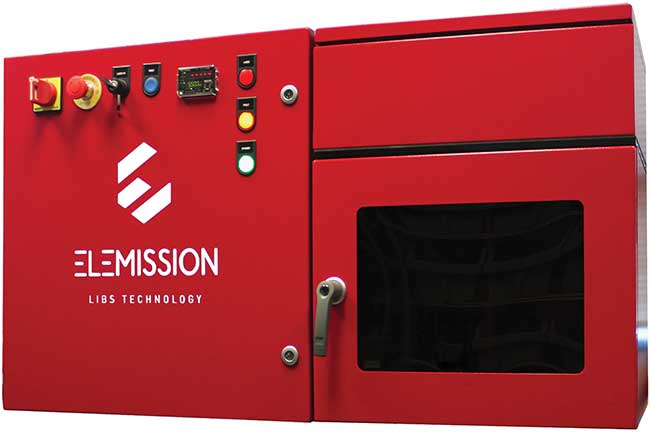Offering advantages over other analytical techniques, laser-induced breakdown spectroscopy is useful in mineral extraction, forensics and point-of-care blood analysis.
BENNO ODERKERK AND JANEL KANE, AVANTES
Laser-induced breakdown spectroscopy (LIBS) techniques have been studied and applied for more than half a century. The first plasma induced by a laser was observed shortly after the invention of the laser itself, but only recently has LIBS moved from research circles to industry.
Here’s how the technique works: A laser pulse instantly heats a small volume of matter to several thousand degrees when focused on a surface for a few nanoseconds. As it cools, this laser-heated matter returns the absorbed energy through visible and invisible portions of the spectrum. Light emission is collected and routed to a spectrometer that separates the various colors onto a detector. From there, spectroscopy characterizes the concentration of each element in the sampled volume as a function of the intensity of its respective spectral lines.
In the last decade, advances in technology and knowledge have made industrial LIBS applications more commonplace. This is driven by the miniaturization and hardening of key system components to enable the deployment of LIBS into the industrial environment. Laser technologies have become more affordable, smaller and more robust to meet the demands of industrial LIBS. At the same time, on the detection side, spectrometers have shrunk and become inexpensive, and their performance has improved. Modular design, fiber interface and high-performance electronics have enabled many industrial customers to reduce cost and maintain performance standards.

Galvalibs system probe submerged in molten zinc bath. Courtesy of Tecnar.
LIBS allows for the rapid measurement, from a distance, of multiple atomic species simultaneously in a single scan with little or no sample preparation. However, taking this technology into the real world raises challenges that LIBS experts have been working to overcome for the last decade.
First, being able to perform measurements at a distance is especially useful for applications in hostile environments, but those same environments offer ambient conditions that are less than ideal for testing. Airborne particulates, condensation and temperature fluctuations can impede a LIBS system’s ability to capture spectral data.
Even once components are hardened to ambient conditions, other technical considerations must be accounted for, including adjusting focal length, selecting ideal wavelength regions and processing out matrix effects — variables that can
drastically change measurement parameters. LIBS also generally requires a robust set of matrix-matched samples to develop
a calibration model that can support qualitative and quantitative measurements.
These standards may or may not exist and require validation using more traditional methods of testing, such as inductively coupled plasma mass spectrometry.
Another challenge that innovators run into when developing an industrial-ready LIBS application is establishing a calibration reference for interpreting sample data. Samples are not always homogenous and neither is the plasma intensity. Calibration-free LIBS is a misnomer because multivariate elemental analysis using LIBS still requires data validation.

Galvalibs industrial probe ready for use beside zinc bath. Courtesy of Tecnar.
Predictably, LIBS has found growing use in mining, mineral extraction, metallurgy and recycling processing. The large body of research into elemental analysis in geochemistry has produced base reference calibration data that can be incorporated into numerous applications. Monitoring metallurgical processes involves measuring the plasma created at the surface of molten metals, in-line systems that monitor raw ore composition in preprocessing, and the quality-management testing of the composition
of alloys in finished ingots.
Molten metal analysis
For the last decade, industrial sensor company Tecnar has been developing a unique LIBS system (Galvalibs) to analyze the composition of molten metal in the galvanizing process. Galvanization involves dipping iron or steel in a bath of molten zinc to protect it from corrosion. The composition of the zinc bath, however, might contain a greater amount of dissolved aluminum or iron depending on the stage in the process and application requirements.

Surface elemental map of aluminum, iron and magnesium nugget. Courtesy of Elemission.
LIBS still competes with traditional measurement methods using arc or spark optical emissions, atomic absorption or inductively coupled plasma spectroscopy throughout the mining, smelting and recycling industries. These traditional measurement methodologies require that physical samples be removed to a lab multiple times per day. Continuous in-line measurements, such as with a LIBS system, taken right at the molten stage can be a significant advantage for the galvanization plants using it.
One of the challenges Tecnar has faced is long-term repeatability. One feature in their design that proved crucial for achieving that was the utilization of a fiber optic spectrometer for use in the UV-VIS range, including a sealed optical bench housing that prevents particulate and humidity infiltration in hostile environments.

Galvalibs probe measuring galvanization mixture in real time. Courtesy of Tecnar.
In addition to industrial hardening of the system, another issue encountered with the development of a continuous monitoring system was delivering nanosecond laser pulses in continuous operation without deterioration. Variability of the laser allows the user to select the settings optimal for the desired response time, from 0.5 to 200 Hz, allowing the user to select the lowest output requirements and extend the life of the laser lamp or diode. Energy can also be varied from 30 to 300 mJ per pulse.
Next up for Tecnar are water-submersible laser modules and power supplies, and advances in designs that are environmentally hardened. The company plans to launch a calibration unit based on certified reference materials. This is expected to eliminate the need for third-party lab calibration of the LIBS system, as it will be able to calibrate itself. The availability of reference data is a key factor in the adoption of LIBS technology and has the potential to replace the laboratory altogether.
Rapid material identification
Coal-fired power generation requires calibrating the fuel mix in real time. Coal is monitored for ash content and other constituents before being fed into the plant combustion chamber. Adjusting the fuel mix in the combustion zone helps plants prevent slagging, increases output and reduces greenhouse gas emissions.
The recycling industry is another opportunity for LIBS applications. Rapid material identification works with in-line
sorting systems to quickly separate plastics and metals. In aluminum recycling, the use of LIBS allows faster and more accurate sorting of scrap metal, which in turn allows recycling plants to run more efficiently and utilize more scrap metal than rough visual sorting allows.
Each LIBS application offers unique circumstances that defy the use of standard solutions. LIBS can offer robust solutions for industry, but there is no one-size-fits-all, off-the-shelf solution that will work for every application. Easily customizable modular solutions can open the door to LIBS industrialization.
Identifying relevant spectral peaks and absorption lines for an application’s desired analytes and overcoming ambient
conditions are the first considerations when designing a LIBS system. Programmability and triggering capabilities are key features for rapid LIBS acquisition. Rapid plasma generation and spectral acquisition must be possible, even with irregular-shaped samples or samples that are not homogenous in composition. System development must also identify wavelength ranges that deliver relevant data. Although multivariate elemental analysis is possible without reference data, system design may require multiple detector channels to adequately cover the wavelength ranges of the absorption lines and spectral peaks in question.
Even when theoretical research has produced reference calibration curves as a starting place, bringing an industrial-suited solution on line requires additional expert development to answer the unique challenges of an application.
Meet the authors
Benno Oderkerk is co-founder and CEO of Avantes, and since 2017 he has served as president of the European Photonics Industry Consortium (EPIC); email: [email protected].
Janel Kane is the marketing specialist for Avantes in North America. She holds a master’s degree in communications from the University of Denver; email: [email protected].
Point-of-Care Blood Analysis
Creative LIBS Solutions, co-founded by industry veteran David Cremers, is developing portable laser-induced breakdown spectroscopy (LIBS) instruments for point-of-care blood analysis. Such instruments can assess blood infected with viruses, bacteria and parasites. Conventional analysis methods typically require extensive sample preparation, trained personnel in laboratory conditions, and can take anywhere from a few hours to a few days to generate results. Creative LIBS’s system delivers diagnostic results in less than 30 min. And this includes sample preparation.
Developing a rapid-response diagnostic instrument required a straightforward sample preparation process. A blood sample must be uniformly applied to a substrate and rapidly dried. Potential pathogens are deactivated, a process that must be simple and fast, but also highly repeatable. Several process methodologies for achieving sample preparation time of 10 to 15 min are being evaluated.
Working with pathogens in blood samples can be tricky because of detection limits. For many pathogens, a very small concentration in the body can be harmful, and blood is a very complex matrix. Creative LIBS tackles this with the use of uniform sample preparation techniques and through development of robust detection algorithms. They also rely on instruments with exceptional thermal stability to reduce noise interference.
In addition to offering potentially lifesaving field diagnostic options, the development work could be consequential for other fields and industries, such as in the rapid detection of chemical, biological, radiological, nuclear and explosive warfare agents or in food production for the detection of harmful food contaminants.
Faster Form of Scanning Electron Microscopy
The direct characterization of chemical states and molecular species that cannot be seen by the human eye is essential for forensics and the pharmaceutical industry. Often these industries employ surface elemental mapping, which takes multiple scans of a sample and then uses the resultant data to create a visual representation or model depicting the location and concentration of constituent elements on the sample surface or near surface.

Surface elemental map of a gold and silver nugget; 1 pixel = 50 µm. Courtesy of Elemission.
The current standard methodology for sample surface elemental mapping is scanning electron microscopy (SEM), coupled with energy dispersive x-ray. Elemission, based in Montreal, has developed a benchtop system that generates a high-resolution SEM image 50× faster without requiring a vacuum chamber or sample preparation, and creates zero ionizing radiation. By reproducing a scanning pattern of 50- × 50-μm test sites at the rate of less than 10 ms per scan, the system can rapidly produce a detailed elemental map of surprisingly large samples.

The Mission: Coriosity System benchtop unit. Courtesy of Elemission.
To achieve rapid adaptation of the optics focal point on the sample’s surface required the development of an innovative and proprietary approach for using a large depth of focus (up to 120 mm) to generate plasmas on any type of sample in any process conditions. To achieve focal depth orders of magnitude larger than a typical LIBS application, the system uses an active focusing linear stage for detecting the presence of samples within a range that extends 120 mm (roughly 4 in.) above the conveyor platform, while simultaneously detecting the position of the sample within the field of focus. This active focusing allows the systems to seek, localize, prepare and analyze up to 100 measurements per second with less than 10 ms per scan.